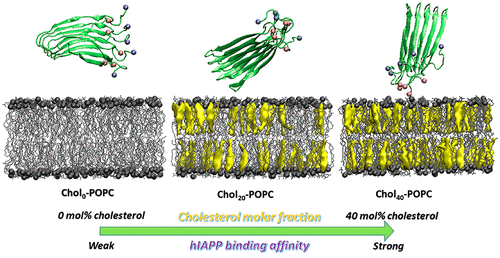当前位置:
X-MOL 学术
›
J. Phys. Chem. B
›
论文详情
Our official English website, www.x-mol.net, welcomes your
feedback! (Note: you will need to create a separate account there.)
Molecular Dynamics Simulations of Cholesterol Effects on the Interaction of hIAPP with Lipid Bilayer.
The Journal of Physical Chemistry B ( IF 2.8 ) Pub Date : 2020-08-10 , DOI: 10.1021/acs.jpcb.0c05742 Yonglan Liu 1 , Dong Zhang 1 , Yanxian Zhang 1 , Yijing Tang 1 , Lijian Xu 2 , Huacheng He 3 , Jiang Wu 4 , Jie Zheng 1
The Journal of Physical Chemistry B ( IF 2.8 ) Pub Date : 2020-08-10 , DOI: 10.1021/acs.jpcb.0c05742 Yonglan Liu 1 , Dong Zhang 1 , Yanxian Zhang 1 , Yijing Tang 1 , Lijian Xu 2 , Huacheng He 3 , Jiang Wu 4 , Jie Zheng 1
Affiliation

|
Fundamental understanding of specific interactions of human islet amyloid polypeptide (hIAPP) with cell membrane is critical for elucidating the underlying pathogenesis of type II diabetes mellitus (T2DM). Membrane cholesterol is known to regulate membrane functions and properties, but its exact role in driving hIAPP–membrane interactions still remains controversial. In this work, we computationally investigated the concentration effect of cholesterol on the adsorption, orientation, and surface interaction of hIAPP oligomers on POPC bilayers containing different amounts of cholesterol (χ = 0, 20, and 40 mol %). Collective MD simulations consistently showed that an increased cholesterol level modulated the structure and dynamics of POPC bilayer, leading to an increase of bilayer thickness, lipid packing order, and surface hydrophobicity but a decrease of lipid mobility. Cholesterol-induced bilayer changes further caused hIAPP oligomer to more preferentially bind to POPC bilayer in the presence of cholesterol via C-terminal residues, in contrast to weak or no binding of hIAPP oligomer on pure POPC bilayers. The cholesterol-enhanced hIAPP–membrane binding is mainly contributed by electrostatic interactions between C-terminal residues and lipid head groups, which may explain the rapid adsorption and aggregation of hIAPP in the presence of cholesterol in cell membranes. This computational work provides some insights into drug development and therapeutic strategies for T2DM by considering cholesterol effects.
中文翻译:

胆固醇对hIAPP与脂质双层相互作用的影响的分子动力学模拟。
从根本上了解人胰岛淀粉样多肽(hIAPP)与细胞膜的特异性相互作用对于阐明II型糖尿病(T2DM)的潜在发病机理至关重要。众所周知,膜胆固醇可调节膜的功能和特性,但其在驱动hIAPP-膜相互作用中的确切作用仍存在争议。在这项工作中,我们通过计算研究了胆固醇对hIAPP低聚物在含有不同胆固醇含量(χ= 0、20和40 mol%)的POPC双层上的吸附,取向和表面相互作用的浓度影响。集体MD模拟始终表明,胆固醇水平的提高调节了POPC双层的结构和动力学,从而导致双层厚度,脂质堆积顺序,和表面疏水性,但脂质迁移率降低。胆固醇诱导的双层变化进一步导致hIAPP寡聚物在胆固醇存在下通过C-末端残基更优先结合POPC双层,这与纯POPC双层上hIAPP寡聚物的弱结合或不结合相反。胆固醇增强的hIAPP与膜的结合主要是由于C末端残基与脂质头基之间的静电相互作用所致,这可能解释了在细胞膜中存在胆固醇的情况下hIAPP的快速吸附和聚集。通过考虑胆固醇的影响,这项计算工作为T2DM的药物开发和治疗策略提供了一些见识。胆固醇诱导的双层变化进一步导致hIAPP寡聚物在胆固醇存在下通过C-末端残基更优先结合POPC双层,这与纯POPC双层上hIAPP寡聚物的弱结合或不结合相反。胆固醇增强的hIAPP与膜的结合主要是由于C末端残基与脂质头基之间的静电相互作用所致,这可能解释了在细胞膜中存在胆固醇的情况下hIAPP的快速吸附和聚集。通过考虑胆固醇的影响,这项计算工作为T2DM的药物开发和治疗策略提供了一些见识。胆固醇诱导的双层变化进一步导致hIAPP寡聚物在胆固醇存在下通过C-末端残基更优先结合POPC双层,这与纯POPC双层上hIAPP寡聚物的弱结合或无结合相反。胆固醇增强的hIAPP与膜的结合主要是由于C末端残基与脂质头基之间的静电相互作用所致,这可能解释了在细胞膜中存在胆固醇的情况下hIAPP的快速吸附和聚集。通过考虑胆固醇的影响,这项计算工作为T2DM的药物开发和治疗策略提供了一些见识。胆固醇增强的hIAPP与膜的结合主要是由于C末端残基与脂质头基之间的静电相互作用所致,这可能解释了在细胞膜中存在胆固醇的情况下hIAPP的快速吸附和聚集。通过考虑胆固醇的影响,这项计算工作为T2DM的药物开发和治疗策略提供了一些见识。胆固醇增强的hIAPP与膜的结合主要是由于C末端残基与脂质头基之间的静电相互作用所致,这可能解释了在细胞膜中存在胆固醇的情况下hIAPP的快速吸附和聚集。通过考虑胆固醇的影响,这项计算工作为T2DM的药物开发和治疗策略提供了一些见识。
更新日期:2020-09-10
中文翻译:

胆固醇对hIAPP与脂质双层相互作用的影响的分子动力学模拟。
从根本上了解人胰岛淀粉样多肽(hIAPP)与细胞膜的特异性相互作用对于阐明II型糖尿病(T2DM)的潜在发病机理至关重要。众所周知,膜胆固醇可调节膜的功能和特性,但其在驱动hIAPP-膜相互作用中的确切作用仍存在争议。在这项工作中,我们通过计算研究了胆固醇对hIAPP低聚物在含有不同胆固醇含量(χ= 0、20和40 mol%)的POPC双层上的吸附,取向和表面相互作用的浓度影响。集体MD模拟始终表明,胆固醇水平的提高调节了POPC双层的结构和动力学,从而导致双层厚度,脂质堆积顺序,和表面疏水性,但脂质迁移率降低。胆固醇诱导的双层变化进一步导致hIAPP寡聚物在胆固醇存在下通过C-末端残基更优先结合POPC双层,这与纯POPC双层上hIAPP寡聚物的弱结合或不结合相反。胆固醇增强的hIAPP与膜的结合主要是由于C末端残基与脂质头基之间的静电相互作用所致,这可能解释了在细胞膜中存在胆固醇的情况下hIAPP的快速吸附和聚集。通过考虑胆固醇的影响,这项计算工作为T2DM的药物开发和治疗策略提供了一些见识。胆固醇诱导的双层变化进一步导致hIAPP寡聚物在胆固醇存在下通过C-末端残基更优先结合POPC双层,这与纯POPC双层上hIAPP寡聚物的弱结合或不结合相反。胆固醇增强的hIAPP与膜的结合主要是由于C末端残基与脂质头基之间的静电相互作用所致,这可能解释了在细胞膜中存在胆固醇的情况下hIAPP的快速吸附和聚集。通过考虑胆固醇的影响,这项计算工作为T2DM的药物开发和治疗策略提供了一些见识。胆固醇诱导的双层变化进一步导致hIAPP寡聚物在胆固醇存在下通过C-末端残基更优先结合POPC双层,这与纯POPC双层上hIAPP寡聚物的弱结合或无结合相反。胆固醇增强的hIAPP与膜的结合主要是由于C末端残基与脂质头基之间的静电相互作用所致,这可能解释了在细胞膜中存在胆固醇的情况下hIAPP的快速吸附和聚集。通过考虑胆固醇的影响,这项计算工作为T2DM的药物开发和治疗策略提供了一些见识。胆固醇增强的hIAPP与膜的结合主要是由于C末端残基与脂质头基之间的静电相互作用所致,这可能解释了在细胞膜中存在胆固醇的情况下hIAPP的快速吸附和聚集。通过考虑胆固醇的影响,这项计算工作为T2DM的药物开发和治疗策略提供了一些见识。胆固醇增强的hIAPP与膜的结合主要是由于C末端残基与脂质头基之间的静电相互作用所致,这可能解释了在细胞膜中存在胆固醇的情况下hIAPP的快速吸附和聚集。通过考虑胆固醇的影响,这项计算工作为T2DM的药物开发和治疗策略提供了一些见识。











































 京公网安备 11010802027423号
京公网安备 11010802027423号